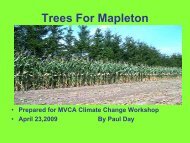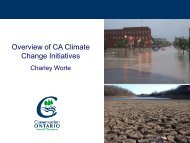challenges and opportunities - Ontario Centre for Climate Impacts ...
challenges and opportunities - Ontario Centre for Climate Impacts ...
challenges and opportunities - Ontario Centre for Climate Impacts ...
- No tags were found...
Create successful ePaper yourself
Turn your PDF publications into a flip-book with our unique Google optimized e-Paper software.
<strong>Climate</strong> change impacts, adaptation<strong>and</strong> mitigation in eastern <strong>Ontario</strong>:<strong>challenges</strong> <strong>and</strong> <strong>opportunities</strong>Dr. Robert McLemanAssociate ProfessorDepartment of GeographyUniversity of Ottawa
Income ($)Rural incomesAddington Highl<strong>and</strong>s township – an extreme case2001 Income of Population 15 Years <strong>and</strong> Over$60,000 <strong>and</strong> over$50,000 - $59,999$45,000 - $49,999$40,000 - $44,999$35,000 - $39,999$30,000 - $34,999$25,000 - $29,999$20,000 - $24,999$15,000 - $19,999$12,000 - $14,999$10,000 - $11,999$ 7,000 - $ 9,999$ 5,000 - $ 6,999$ 3,000 - $ 4,999$ 1,000 - $ 2,999Under $1,0000 50 100 150 200 250 300Number of People
Capital value of farms, 2006%Source: OMAFRA http://www.omafra.gov.on.ca/english/stats/county/eastern_ontario.pdf
% farmsGross farm receipts, 2006Source: OMAFRA http://www.omafra.gov.on.ca/english/stats/county/eastern_ontario.pdf
% farmsFarm types, 2006Source: OMAFRA http://www.omafra.gov.on.ca/english/stats/county/eastern_ontario.pdf
Millions $Farm revenues, Eastern <strong>Ontario</strong>2009Source: OMAFRA http://www.omafra.gov.on.ca/english/stats/county/eastern_ontario.pdf
Eastern <strong>Ontario</strong> agriculture,overall picture• Mostly small, family farms; not many living“off the barn” (i.e. much income comes fromoff-farm work)• A lot of pasture & hay, small corn/soyoperations (only ½ of total farm area is incrops)• Not a lot of heavy irrigators• Biggest revenue farms are dairy, but theserepresent ~15% of farms• Forestry important sector as well
Climatic trends, last 2-3 decades, fromanecdotal & partial data• Shorter, milder, less snowy winters, springcoming earlier• Summer temperatures hovering in upper endof historical range, fewer cool summers• Microbursts frequent
19561958196019621964196619681970197219741976197819801982198419861988199019921994199619982000200220042006Day pulled OutSugar bush recordsHasler Farm Maple Sugar BushDate taps removed from trees, by year13012512011511010510095908580Year
1880189019001910192019301940195019601970198019902000Temperature ( o C)Hot, dry summers more frequent20Average Monthly Means <strong>for</strong> May, June, July <strong>and</strong> August (1882-2006)Bancroft data151050-5-10-15Year
Wind events
Changing fire risks?
Localized water-table worriesDry beaver pond, Addington Highl<strong>and</strong>s ON, September 20
Ice storm, 1998• Impact on dairy operations, maple sugarbushes, orchards• Wheeler’s Maple products (<strong>Ontario</strong>’s largestproducer) lost 1/3 of their taps; many largetrees died in subsequent years or struggled toproduce
Extreme rainfall events, 1979-2004Relatively rare in Eastern<strong>Ontario</strong>Source: NRCan national assessment
Eastern <strong>Ontario</strong> agriculture& climate change linkages?• Highly variable climate, large range acrossregion• Very different soils across region• Lots of small producers, differing farmcharacteristics• Many areas lack historical weather records• Difficult to model at local scales the types ofclimate events that concern rural populations
<strong>Climate</strong> change concerns of Eastern<strong>Ontario</strong> agriculturalists• Crop farmers are hopeful mild temperatureswill generally be beneficial• Worried about spread of pests, combinedheat/dry events, extreme weather events,storms• Mild winters: impacts on logging, snow & icetourism visits• Foresters, sugarbush operators worry aboutstress on commercially valuable hardwoodsFrom S<strong>and</strong>er-Regier et al 2010; McLeman 2010
Non-climatic stressors = cumulativelygreater, ongoing risk• Rising input prices (fuel, chemicals, fertilizers)• Fluctuations in commodity prices• These may be influenced by impacts ofclimate change elsewhere• Also US$ fluctuations – big impact on <strong>for</strong>estry• US import regulations – beef producers• Urban sprawl
Adaptation & mitigation• Priority <strong>for</strong> rural eastern <strong>Ontario</strong> = reduceexposure to climate & non-climate risksthrough income diversification• A number of <strong>opportunities</strong> <strong>for</strong> combinedadaptation & mitigation
Local food networks & agri-tourism• CSAs, farm-gate & farmers market sales• Co-ops• Shift to high-margin products, includingheritage varieties• Good adaptation benefits• Mitigation benefits? Small, but important
“Polyculture” CSA farming
Alternative energy• Significant uptake of solar due to FIT; wind &geothermal to lesser extent• Foresters exploring wood-chip fuel• Good combination adaptation & mitigation• Corn ethanol plant at Johnstown: good <strong>for</strong>corn growers; actual mitigation questionable
Chip-fuel test in AddingtonHighl<strong>and</strong>s
Small-scale <strong>for</strong>estry• Eastern <strong>Ontario</strong> Model Forest initiatives• Depressed prices real challenge at present• Always a market <strong>for</strong> firewood
Maple syrup• Strong growth industry• Good <strong>for</strong> biodiversity, watershed health• Still principally a family-type operation• Encourages maintenance of <strong>for</strong>ests (good <strong>for</strong>mitigation)
Innovative technologies• Enhance efficiency, marginal income fromongoing activities• Reduce exposure to climate uncertainty• Diversify income <strong>opportunities</strong>• Retain rural youth
Adaptation <strong>challenges</strong>• Farmers typically under-capitalized• Lack of off-farm employment<strong>opportunities</strong>• Young people leaving, schoolsclosing• Aging population with poor healthcare• Lack of broadb<strong>and</strong> & wirelessconnectivity hampers economicdevelopment
Community-level <strong>opportunities</strong>• Mobilize social capital• Engage citizenry in environmental monitoring• Getting schools involved
Opportunities <strong>for</strong> government(including CAs)• Trim government red tape(e.g. water, planningprocesses) while raisingawareness of gov’tprograms• Foster rural tourism(diversify rural economy)• Champion citizen science
Thanks! Merci!Robert McLemanAssociate Professore-mail: rmcleman@uottawa.caweb: http://www.geography.uottawa.ca/prof/rmcleman.htmblog: http://www.thisgeographicallife.blogspot.com








